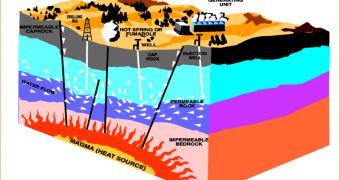Geologists from the University of California, Davis are taking part in the Iceland Drilling Project, in an international program to learn to exploit the full potential of geothermal energy, extracted from hot dry rocks. Hot Dry Rock Geothermal Energy or HDR is a new type of producing power, by using the heat found in rocks a few kilometers underground.
The technique consists of drilling holes into areas with increased geological potential, to insert a circuit through which water can be cycled. Water is sent traveling down through a primary hole, seeps through fractures of the rock below, captures heat and is being forced out through a second hole in the ground. Usually the water coming out can be used as Steam to power stem turbines, to generate electricity, after which the cooled water exiting the turbine is pumped back in the ground to complete the cycle.
This way cheap electric energy can be produced out of renewable energy sources, without polluting Earth atmosphere.
Professors Peter Schiffman and Robert Zierenberg are collaborating with Wilfred Elders, Dennis Bird and Mark Reed to study the complex chemical reactions that take place at high pressures and temperatures, three kilometers underground, when water is circulated at depth.
The study, funded by the National Science Foundation, will drill a hole as far as up to four kilometers into the hot rock, part of a program supported by Icelandic power companies, which has planned to drill other two boreholes.
More than half of the electric power produced in Island is generated from geothermal energy, steam from boreholes being used to run steam turbines for electricity, or to directly heat homes and other buildings, the other half of the necessary electric power being produced through classical ways.
The United States has relatively high geothermal potential, mostly around California, where some power plants operate using this technology, plus the Geysers region in the north of the country, Geysers being the largest geothermal field in the world. Scientists say that even some of the abandoned oil and gas boreholes around geothermal areas could give access to hot water that could be used for heating spaces and buildings.
Although this is a marvelous source of energy, most areas with geothermal potential are located near fault lines and geologically active. This kind of energy harnessing activity can pose security problems, regarding earthquakes. Such an incident happened in December 2006, in Switzerland when after 8 days after water had been injected into the ground, an earthquake with a magnitude of 3.4 on the Richter scale occurred, with the epicenter at the bottom of the HDR borehole. Water pumping stopped immediately and the tremor triggered over one thousand replicas that caused minor structural damage to several buildings.

 14 DAY TRIAL //
14 DAY TRIAL //